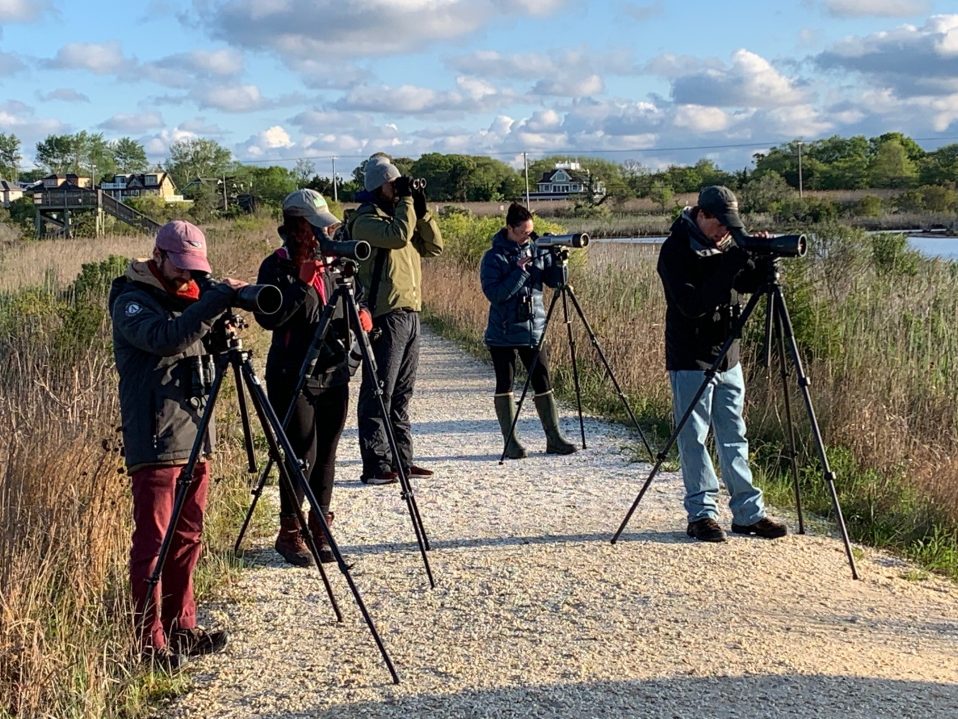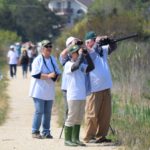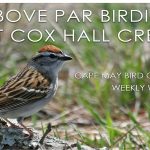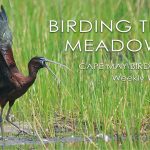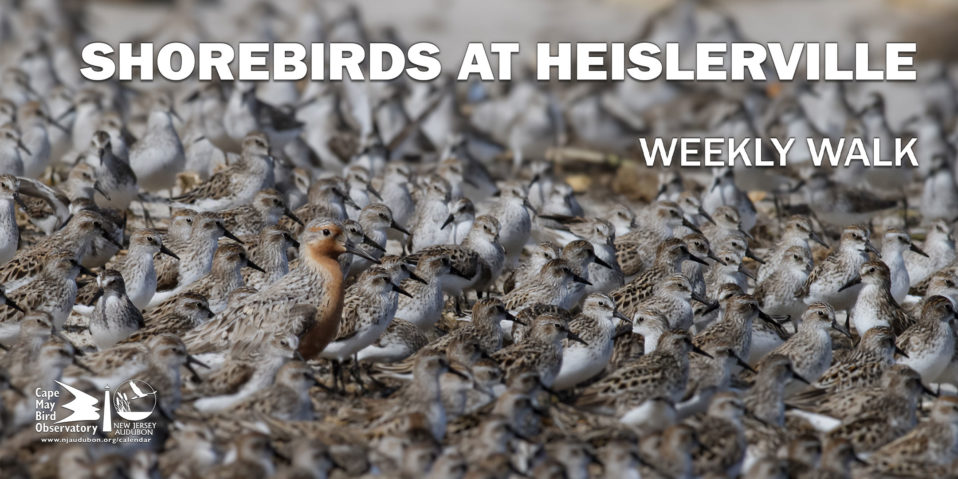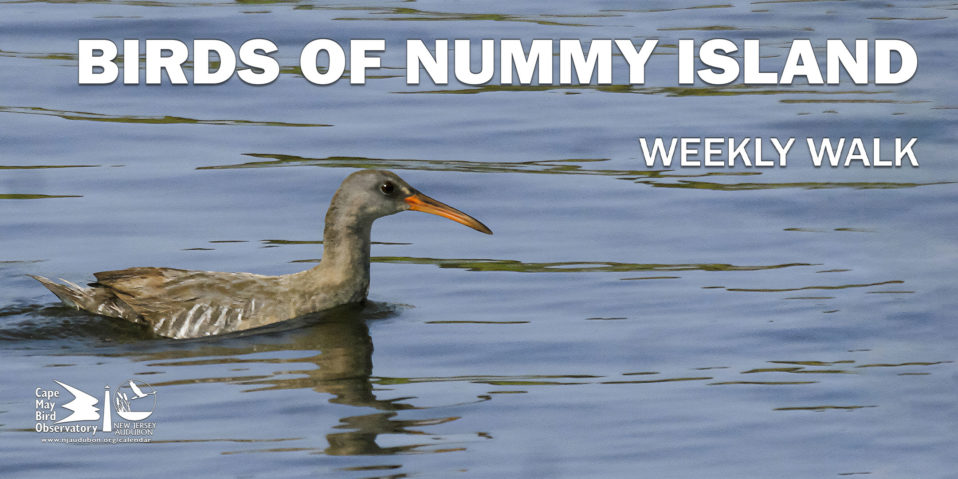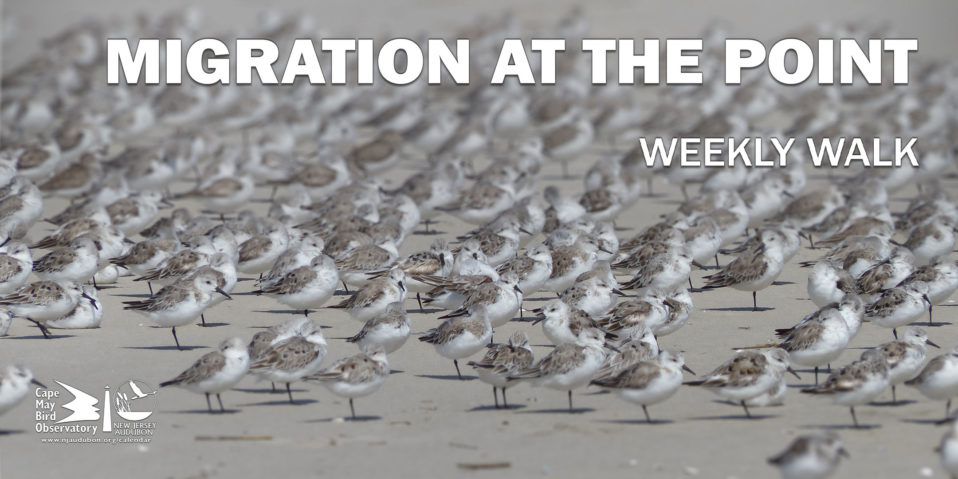World Series of Birding 2021! The sophomore effort of Off the Rails, a team composed of seasonal staff both past and present (and future?), will be one to remember or at least try to remember; much of the day is now a blur. While this was our second year as a team, it was our first time competing as a unit! Since four of the five members of the team are currently based in Cape May and this is the place we know and love the best, we decided to compete in the Cape May County division of WSB. In 22 hours of birding, we logged 171 species over 31 checklists and nearly 250 miles! Here’s a little recap of the day:
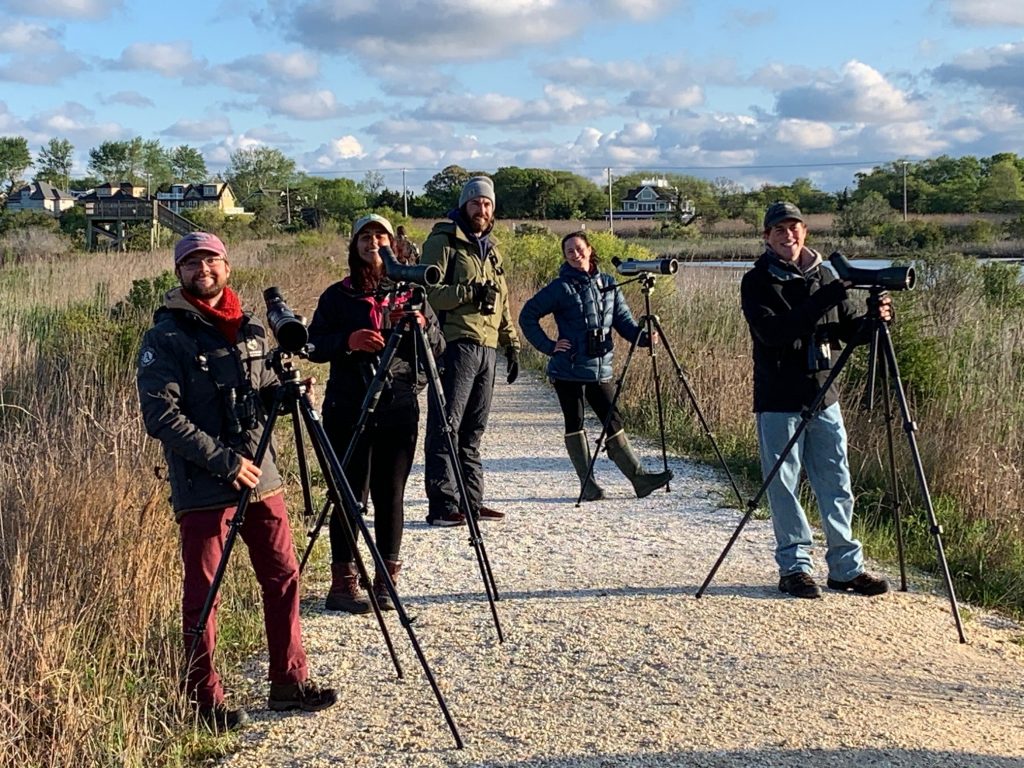
All smiles with the sunrise at the South Cape May Meadows; the team is fresh off a Sora sighting! Pictured from left to right: Will Kaselow, Taleen Demirdjian, Jesse Amesbury, Melissa Roach, and David Weber. Photo credit Brett Ewald.
After a few hours of attempting to sleep, we set off for our starting location. The encroaching dark and illuminated mist set a close and quiet nocturnal scene that I’m sure most teams experienced. This would be the theme of the first night: fog that clung a few feet from the road’s surface and patches of rain that punctuated a constant drizzle. These conditions made for tough birding, and I learned of the dreaded “canopy drip.” Canopy drip refers to the sound of millions of leaves shedding raindrops after a storm; a lovely hindrance to birding by ear. We gave it our best, moving from marsh to forest to field and back again. For our efforts, we came away with about half of our nocturnal targets including both of the vocal nightjars and Horned Lark. Perhaps the toughest miss of the night was Least Bittern; we spent what felt like the majority of the night standing on the side of increasingly soggy marsh roads and came up empty handed. Oh well.
The dawn was welcome. With UV rays and Vitamin D doing a job that caffeine never could, we were feeling rejuvenated. We decided to post up on the East dune crossing at the South Cape May Meadows to try and rack up as many migrant seabirds, shorebirds, and songbirds as we could. We managed to detect more than a few troublesome species like Bonaparte’s Gull, Red-throated Loon, Cooper’s Hawk, and Wilson’s Snipe right off the bat and enjoyed a gorgeous sunrise. Watching swallows follow the dune down toward the lighthouse gave us visions of the fall, but we had to move on.
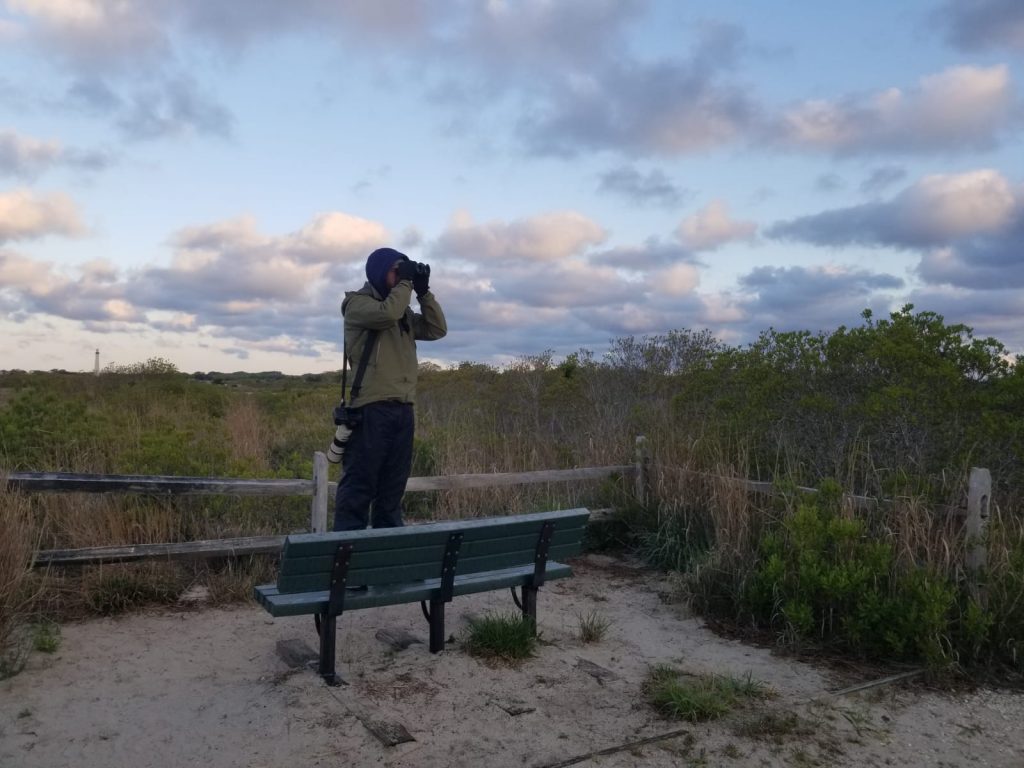
Jesse Amesbury looks out for any arriving songbirds and shorebirds coming in to forage. Photo credit Will Kaselow.
After leaving the meadows, we wandered West Cape May by car listening for migrants and, unsurprisingly, we found our best luck around Lily Lake. Around the lake, we found Black-throated Blue Warbler, Cliff Swallow, Cape May Warbler, and Warbling Vireo. We continued to St. Peter’s Dune Crossing for the second of what would be many failed attempts to see Royal Tern and Brown Pelican. We did pick up a surprise Red-Headed Woodpecker there though, so it was worth the stop.
After the obligatory stop at Higbee Beach for the loneliest Swainson’s Warbler, we left Cape Island for the morning’s main event: Cox Hall Creek. We spent a whopping hour at Cox Hall, and it did not disappoint (it never does in my humble opinion). While we missed a few birds that had been there reliably over the previous week, we still managed to pick up elusive migrants like Bay-breasted Warbler as well as breeders like Summer Tanager and Prothonotary Warbler that took some of the pressure off of our afternoon trip to Belleplain.
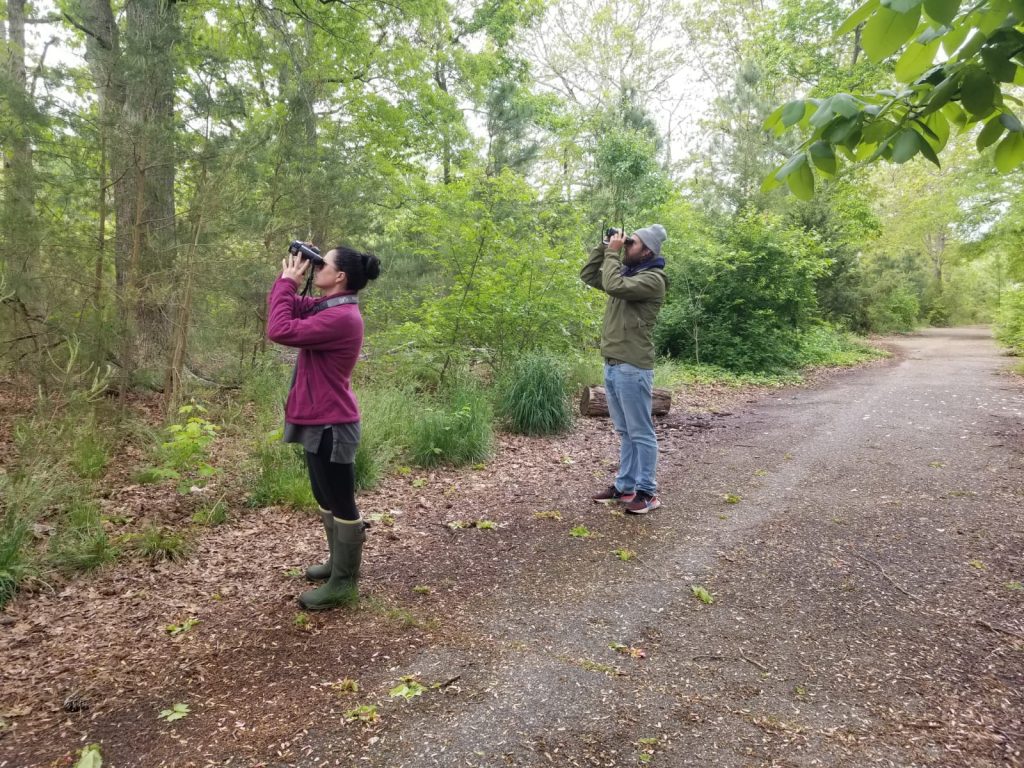
Melissa Roach (left) and Jesse Amesbury (right) tracking down warblers at Cox Hall Creek WMA. Photo credit Will Kaselow.
With wet weather closing in on us, we decided to push off breeding birds until a little later in the day and opted to return to the island to tie up some loose ends and maybe get lucky. We started with some windy and unproductive hawkwatching at Stevens Street followed by return trips to St. Peter’s and the Meadows, yielding a handful of new species. At the Meadows, we managed to see a couple of shorebirds that we had missed in the morning, Pectoral Sandpiper and Greater Yellowlegs, and wrapped up the swallows by spotting Bank and Northern Rough-winged Swallows. We had made it to the halfway point – 12 noon – and there was at least one person feeling the effects of no sleep (hint: it was me).
With the morning behind us, it was time to head north for breeding birds. Belleplain State Forest is a critical stop for most WSB teams during the day. This part of the route can make or break a day, and we had a mixed bag. Upon arrival, things looked promising. It seemed that the overcast conditions were keeping birds active later into the day than they normally would, and we picked up a few targets including Louisiana Waterthrush, an early spring arrival that can be stubbornly quiet on WSB. Along with the waterthrush, we had Scarlet Tanager, Veery, Wild Turkey, and Hairy Woodpecker. Because we had already seen so many breeding birds at Cox Hall, we were able to move through Belleplain with speed, something we really needed at this point in the day. We hit patches of drizzle and had some tough misses, most notably Hooded Warbler as well as Yellow-throated Vireo and Blue-winged Warbler. We did have a couple surprises in the form of Blackburnian Warbler and Red-shouldered Hawk calling from the wet woods. However, our time was up and we had to move on.
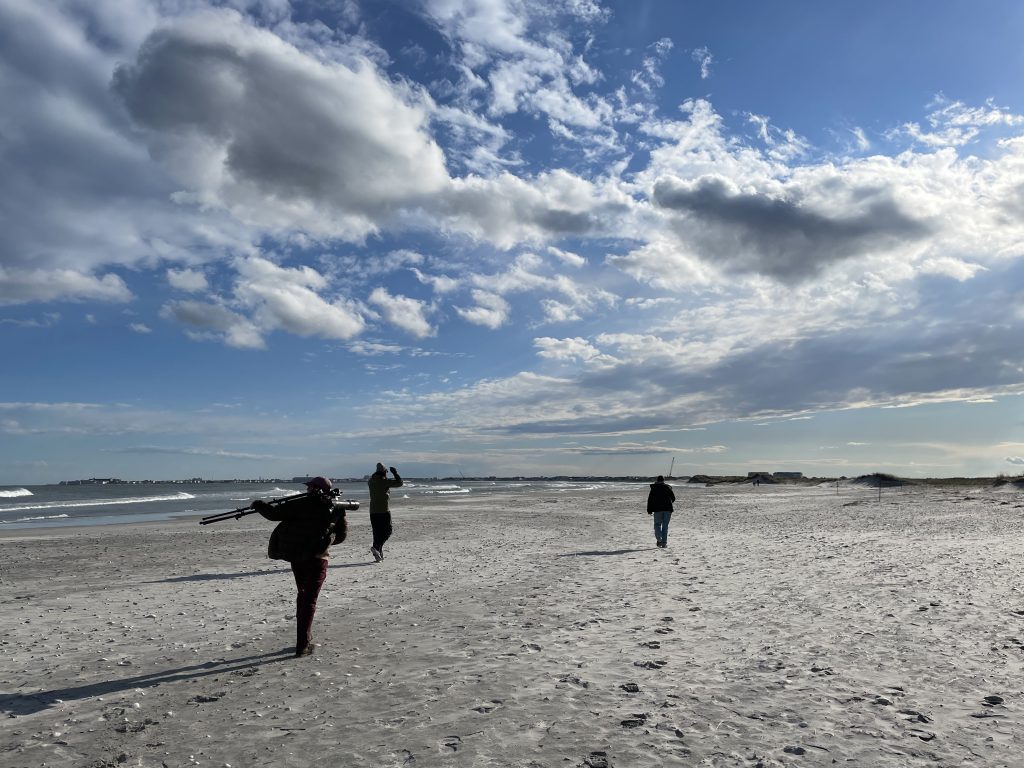
The skies began to clear and so did our heads as we ran down to the beach at Stone Harbor Point! Photo credit Melissa Roach.
The barrier island blitz breathed some new life into us for what would amount to our 8th or 9th wind. We picked up new birds from Avalon all the way down to Wildwood and treated ourselves to such classic WSB moments as sprinting down the trail at Stone Harbor and getting stuck in tourist traffic. Along the way, there was the now-famous Harlequin Duck at Avalon Seawatch, the many waders and shorebirds of the barrier marshes, and a few surprises including a brief hailstorm at Avalon Manor. Sunset Lake lived up to its name and Two Mile Landing delivered in a big way by producing an immature Great Cormorant perched up on a channel marker. Finally back on the island, we picked up a surprise Bufflehead that made up for the absence of one at a stake-out location and relieved some of the bitterness we felt towards a rogue jet-ski that presumably disturbed the birds there.
As the sun continued its westward plunge, we obeyed the speed limit all the way to the Magnesite Plant. On our way in, we cheered on a female Northern Harrier as it cruised low over the scrub and were spared an embarrassing miss when a Brown Thrasher sounded off along the trail. As we cleared the phragmites and looked out onto Pond Creek, we found our friends and competitors from Zen Zugunruhe already posted up and waiting for lift off. The marsh was sporting its golden-hour glow and the clouds, once threatening, were now a cotton candy pink against Little Blue Heron blue. We had some great birds to compliment the scenery including Bobolink, Common Nighthawk, and Yellow-breasted Chat.
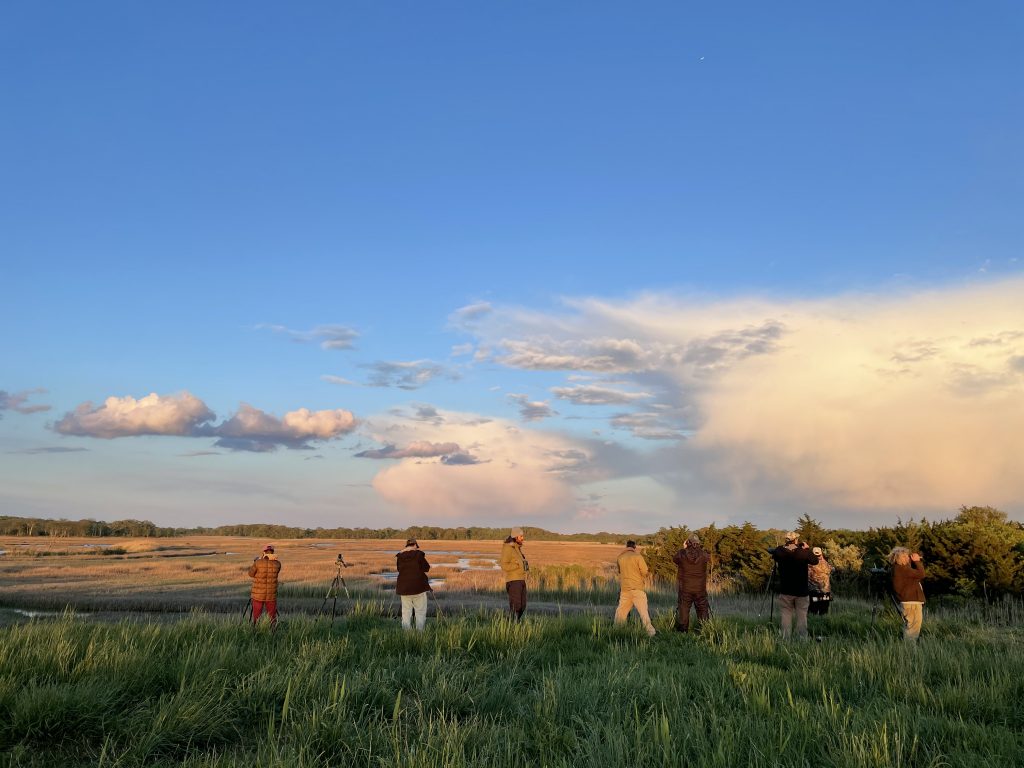
We forget about the (friendly) competition for a few minutes to enjoy the sunset at Pond Creek Marsh with Zen Zugunruhe. Photo credit Melissa Roach.
Once the sun was solidly beneath the horizon, the stiff breeze off the bay began to bite a little harder and we rushed to the Meadows for one last attempt at Virginia Rail, Sedge Wren, and Green-winged Teal; none would be had. We weighed our options and decided that our last best chance for a new bird was Eastern Screech Owl; this decision may have been influenced by the fact that we wouldn’t have to leave the island to try. We had a few chances for Screech Owl on the island and were ousted at the first two, but at the third we managed to whistle one in. That brought us to 171 species, a total we could be proud of. The end of a long and challenging day was bittersweet, little did we know we had won!
The World Series of Birding is an event that many of us look forward to every year, and this year was no exception. With a hint of normalcy regained, some of us were able to bird together while the event maintained a flyway-wide reach. For people to come together from Florida to Maine and beyond in celebration of birds and conservation is a special thing; so thank you to all who were involved from participants to organizers and, of course, to the many donors that ensured this event has the impact that it does. We’ll see you next year!
By Will Kaselow




